|
|
|
Sort Order |
|
|
|
Items / Page
|
|
|
|
|
|
|
| Srl | Item |
| 1 |
ID:
137853
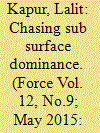

|
|
|
|
|
| Summary/Abstract |
The launch of the first Scorpene built by Mazagon Docks Limited (MDL) on 6 April 2015 received extensive media coverage. It marked reawakening of indigenous submarine construction capability, which had been sent into hibernation by an indecisive and myopic defence ministry in 1994.
|
|
|
|
|
|
|
|
|
|
|
|
|
|
|
|
| 2 |
ID:
129365
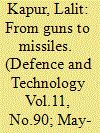

|
|
|
|
|
| Publication |
2012.
|
| Summary/Abstract |
Is an alumnus of the defence services staff college and the college of defence management, was directing staff at DSSC ad the college of naval warfare, Mumbai; has been the defence adviser at Muscat had held several important tri-service and naval appointment.
|
|
|
|
|
|
|
|
|
|
|
|
|
|
|
|
| 3 |
ID:
150687
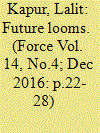

|
|
|
| 4 |
ID:
154632


|
|
|
| 5 |
ID:
147355
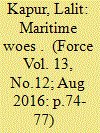

|
|
|
|
|
| Summary/Abstract |
In his speech presenting independent India’s first budget, R.K. Shanmukhan Chetty, India’s second finance minister (the first was Liaquat Ali Khan, who migrated to Pakistan in 1947 to become that country’s first prime minister), acknowledged, “India has never had an adequate navy or air force and the effect of Partition has been to reduce them still further”. The defence budget for 1947-48 was Rs 92.74 crores, just under 47 per cent of the budgeted government expenditure of Rs 197.39 crores. The Indian Navy’s (IN) share of the defence pie was less than 2 per cent. Comparing this with the 19.29 per cent of the defence budget allocated to the navy in 2012-13 and coupling it with India’s maritime outreach in the Indian Ocean and beyond, as well as the oft-stated desire to be a ‘net security provider in the Indian Ocean Region’, one could be pardoned for thinking that the nation’s leaders are at last paying adequate attention to the maritime matters and (IN) force levels are destined to rise.
|
|
|
|
|
|
|
|
|
|
|
|
|
|
|
|
| 6 |
ID:
137876


|
|
|
|
|
| Summary/Abstract |
According to statistics on the ministry of petroleum and natural gas website, the offshore sector accounted for production of 18.2 million tonnes of crude oil (over 48 per cent of the nation’s domestic production) and 72.3 MMSCMD of natural gas (74.5 per cent of the domestic production) in 2013-14. The collective value of this annual output, even at the current depressed price of around USD 45 per barrel, is nearly USD 13.9 billion or over Rs 86,000 crore. The replacement cost of the infrastructure for extraction of oil and gas from sub-sea fields, at a conservative estimate, is well in excess of Rs 250,000 crore. Is enough being done to secure this strategic national asset?
|
|
|
|
|
|
|
|
|
|
|
|
|
|
|
|
| 7 |
ID:
135660


|
|
|
|
|
| Summary/Abstract |
On 26 February 2014, a fire broke out on board INS Sindhuratna, a submarine undergoing workup at sea, off Mumbai, after refit. The fire was quelled using inbuilt fire-fighting systems, but caused nine casualties: two officers died and seven sailors had to be evacuated to hospital.
|
|
|
|
|
|
|
|
|
|
|
|
|
|
|
|
| 8 |
ID:
138645
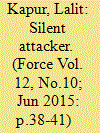

|
|
|
|
|
| Summary/Abstract |
Soon after Lt Gen. A.A.K. Niazi surrendered to Lt Gen. J.S. Aurora on 16 December 1971, the Indian Navy (IN) was tasked to prepare Bangladesh ports for resumption of seaborne traffic, including clearing their approaches. The Mukti Bahini was known to have laid influence mines across the entrance to Pussur River (leading to Chalna and Khulna), while interrogation of Prisoners of War (POWs) revealed that the Pakistan Navy (PN) had laid 94 moored contact mines in the approaches to Chittagong. IN ships Cannanore (a coastal minesweeper), Bulsar and Bhatkal (both inshore minesweepers) began their task on 18 January 1972. This marks the only time that the IN has carried out minesweeping under operational conditions. Given IN aspirations for sea control, it would be wise to factor in the lessons from this experience.
|
|
|
|
|
|
|
|
|
|
|
|
|
|
|
|
| 9 |
ID:
137865
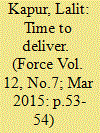

|
|
|
|
|
| Summary/Abstract |
Military platforms, whether tanks, artillery guns, aircraft, ships, submarines or helicopters are enormously complex mechanisms comprising numerous different systems, such as propulsion, transmission, power generation and distribution, each individual weapon, each sensor, communications, electronic warfare, fire-fighting, cooling, hydraulics etc. Each system is designed with redundancies and comprises numerous different subsystems, assemblies, subassemblies and component parts. No manufacturer makes all the component units that go into the platform; he invariably sources them from ancillary industry that fulfils requisite specifications at the most economical price. The source, particularly for dual use units, could be located anywhere on the planet. India’s Hindustan Aeronautics Limited (HAL), for example, produces about half of the forward passenger doors used by Airbus A 320 aircraft globally.
|
|
|
|
|
|
|
|
|
|
|
|
|
|
|
|
|
|
|
|
|